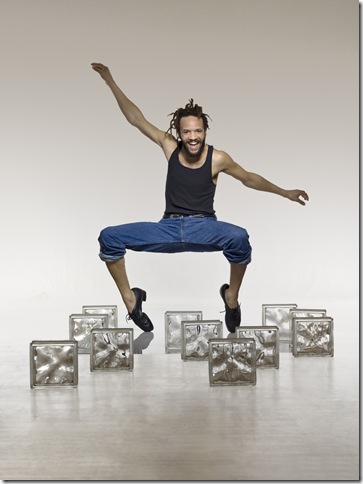By Tara Mitton Catao
Simple clothing and straightforward staging, bathed in vibrant lighting, set the mood Thursday at the Kravis Center for an exuberant foray into the world of Savion Glover and his virtuosic tap dancing.
At the ripe age of 39 (and after having performed professionally for almost three decades), Glover is recognized as one of the most famous tap dancers in the world. He started early, making a name for himself by age 10 as the lead on Broadway in The Tap Dance Kid.
Later, he starred in and was the Tony Award-winning choreographer of Bring in ‘da Noise, Bring in ‘da Funk. His credits include projects in film, television and education, but his passion is to maintain tap dancing as an art form in the modern dance world.
In STePz, Glover’s newest production, which he both choreographed and directed, the dancers created an amazing cacophony of rhythms which were so intricate and rapid that their feet were a continual blur. At other times, their moves were intimate and subtle.
Choreographically, Glover covered a lot of ground in STePz. He even managed to pay homage to the great hoofers of yesterday who led the way to today as he and his modern-day troupe regaled us with an endless variety of intricate steps.
Glover was joined by the magnificently skillful tap dancers Marshall Davis Jr. and the 3CW (3 Controversial Women) — Robyn Watson, Ayodele Casel and Sarah Savelli. They all pounded out a never-ending variety of rhythms in tight footwork as their upper bodies moved loosely with arms flung in different directions.
Starting with what seemed to be a free improvisation to get warm up and revved up, the dancers continued tapping their way to music from Miles Davis to Stevie Wonder to Dmitri Shostakovich. Dancing on a large, raised box set in the middle of the stage that amplified their steps, the five of them eased on down to precision unison in When the Lights Go Down.
In Dexterity, Glover and Davis took to a pair of doubled-sided stairs challenging each other with their dueling footwork. Hurling up and down their set of stairs, each defied the possibilities of how fast and intricate they could tap, making any memory of Fred Astaire seem tame and lame.
There was a hint of humor in Shasta as the dancers poked fun at the elitism of ballet as they mimed ballet vocabulary and combined it with their lighthearted tapping feet to music by Shostakovich.
Then came a theatrical twist. The energetic and fun moves segued into a section where the tapping became less about dancing and more about sound. At one point, the ensemble of feet sounded like horses coming down a quiet, cobblestone street. This inversion led the way to a powerful and intimate solo with delicate transitions and careful theatrical attention.
Glover managed to transform his sounds and make his vibrating rhythms seem to come from his soul, thus conveying fear and vulnerability. His rhythms now seemed like a private, agitated conversation in his mind.
The sounds and gestures made his fellow dancers, one by one, move away from him. His movements so subtle, almost non-existent, it seemed impossible the persistent and ascending sounds were emanating from him.
Then, one foot emerged, delicately vibrating at an incredible speed as it went out to his side, the volume decreased as it disappeared and increased as it returned.
The second half of the program was the same high level of great dancing to great music. There was another staircase dance called Bugle Call Rag in which the 3CW performed more traditional tap reminiscent of World War II movie musicals. They danced fluidly across the wide staircase, without losing a single beat, and in high heels, no less.
Rounding out the program was one more staircase duel, a couple more ensemble works and another outstanding solo for Glover choreographed to Mr. Bojangles, in the recording by Sammy Davis Jr., no mean dancer himself.
After experiencing the pulsating world of Glover in STePz, one couldn’t help leaving the theater with an enthusiasm for the future of tap as an art form and a heightened appreciation for the virtuosity of dancers.
